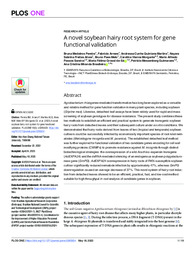A novel soybean hairy root system for gene functional validation.
A novel soybean hairy root system for gene functional validation.
Autoria: PEREIRA, B. M.; ARRAES, F.; MARTINS, A. C. Q.; ALVES, N. S. F.; MELO, B. P.; MORGANTE, C. V.; SARAIVA, M. A. P.; SA, M. F. G. de; GUIMARAES, P. M.; BRASILEIRO, A. C. M.
Resumo: Agrobacterium rhizogenes-mediated transformation has long been explored as a versatile and reliable method for gene function validation in many plant species, including soybean (Glycine max). Likewise, detached-leaf assays have been widely used for rapid and mass screening of soybean genotypes for disease resistance. The present study combines these two methods to establish an efficient and practical system to generate transgenic soybean hairy roots from detached leaves and their subsequent culture under ex vitro conditions. We demonstrated that hairy roots derived from leaves of two (tropical and temperate) soybean cultivars could be successfully infected by economically important species of root-knot nematodes (Meloidogyne incognita and M. javanica). The established detached-leaf method was further explored for functional validation of two candidate genes encoding for cell wall modifying proteins (CWMPs) to promote resistance against M. incognita through distinct biotechnological strategies: the overexpression of a wild Arachis -expansin transgene (AdEXPA24) and the dsRNA-mediated silencing of an endogenous soybean polygalacturonase gene (GmPG). AdEXPA24 overexpression in hairy roots of RKN-susceptible soybean cultivar significantly reduced nematode infection by approximately 47%, whereas GmPG downregulation caused an average decrease of 37%. This novel system of hairy root induction from detached leaves showed to be an efficient, practical, fast, and low-cost method suitable for high throughput in root analysis of candidate genes in soybean.
Ano de publicação: 2023
Tipo de publicação: Artigo de periódico
Unidade: Embrapa Semiárido
Palavras-chave: Agrobacterium rhizogenes, Glycine Max, Melhoramento Genético Vegetal, Meloidogyne spp, Soja, Soybeans, Transgenic soybean
Observações
1 - Por padrão são exibidas publicações dos últimos 20 anos. Para encontrar publicações mais antigas, configure o filtro ano de publicação, colocando o ano a partir do qual você deseja encontrar publicações. O filtro está na coluna da esquerda na busca acima.
2 - Para ler algumas publicações da Embrapa (apenas as que estão em formato ePub), é necessário ter, no celular ou computador, um desses softwares gratuitos. Sistemas Android: Google Play Livros; IOS: iBooks; Windows e Linux: software Calibre.
Acesse outras publicações
Acesse a Base de Dados da Pesquisa Agropecuária (BDPA) para consultar o acervo completo das bibliotecas da Embrapa.

